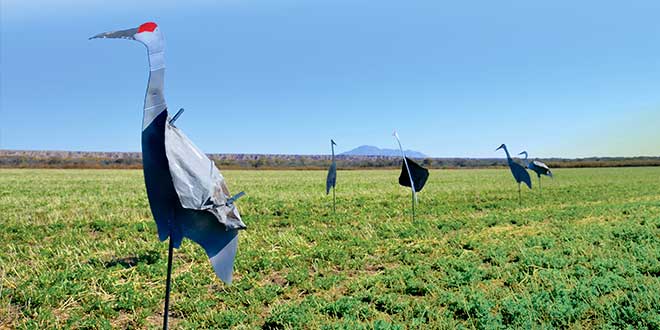I sat on the edge of a cornfield with my son and his friend. White clouds exploded from our mouths with each breath. It was early November, and this sandhill crane hunt would be my son’s first hunt. He had drawn a coveted youth permit to hunt cranes on the New Mexico Department of Game and Fish Casa Colorada Wildlife Management Area (WMA) in 2014, (see note #1).
A mixture of trepidation and anticipation ran through my mind before sunrise. My son was 13 years old and said he wanted to try hunting after watching me duck hunt alone for a season. He had passed the quiz for the department’s mentored-youth hunter program in 2013, since he hadn’t taken a hunter education course yet. Would he enjoy the experience enough to do it again? Could this shared outdoor time strengthen our father-son bond and bring us closer together? Would this activity create a lifetime love of the outdoors? Would he get shots at cranes and maybe harvest his bag limit of three? (See note #2). All these thoughts flew through my head as we waited for the cranes to fly over our meticulously arranged decoys.
My son asked me how hard it was to clean a harvested animal. I told him it wasn’t difficult at all, and we could do it together the first few times. He also wanted to know how much to lead (put the front bead on top of the shotgun) a bird in the air. I told him it would depend on the velocity of the bird and that he could practice by shooting clay pigeons at a skeet or trap range.
First time hunters, like my son, will also have a few concerns:
A few other concerns that new hunters have include:
?How do I learn how to hunt (equipment, locations, firearm safety, rules)? Take a New Mexico Department of Game and Fish hunter education course, join a specific hunting organization such as Ducks Unlimited, Rocky Mountain Elk Foundation or Mule Deer Foundation, get paired with a mentor from Game and Fish volunteers, take a department hunting skills-based camp, study the Big Game Hunting Rules and Information Booklet. ?What if I want to go hunting but can never draw? New Mexico offers a myriad of small game hunting opportunities. The small game license is over the counter and does not require someone to be lucky in the draw. Small game species include: grouse, quail, dove, waterfowl, squirrel, cranes and turkey. ?Will hunting be an expensive hobby? It can be, but when you boil it down a license, firearm and comfortable clothing are all that are necessary to harvest an animal. All other gear is superfluous.I enjoyed watching the crane hunt, my son beaming as new waves of calling cranes flew over. He shot at and missed most, but managed to harvest three large sandhill cranes. His friend, who didn’t have a permit, had fun finding the large birds in the tall corn.
As we were cleaning the birds I asked him if he wanted to go hunting again.
His face lit up and he nodded enthusiastically.
- Tell someone exactly where you are going and when you will be back.
- Don’t hunt alone.
- Do your homework, make phone calls and scout your hunting area ahead of time.
- Take a Hunter Education course, even if you are older than 18.
- Have first aid and survival kits in your backpack.
- Bring more food and water than you think you will need.
- Buy a GPS unit and learn how to use it.
- Make sure you have fresh batteries in your GPS.
- Sight in your firearm or bow before the hunt starts.
Notes:
#1 – This WMA is now leased out for farming by a private individual and is not open to public access except for one youth sandhill crane hunt per year.
#2 – The limit of three sandhill cranes has since changed to a limit of two.
 New Mexico Wildlife magazine Conserving New Mexico's Wildlife for Future Generations
New Mexico Wildlife magazine Conserving New Mexico's Wildlife for Future Generations
